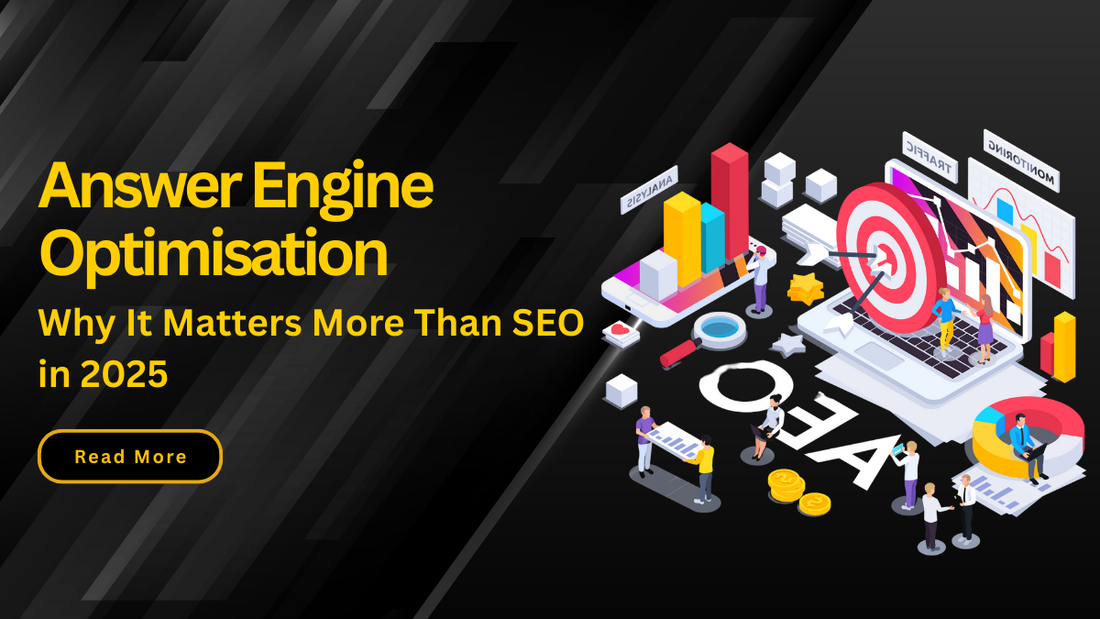
Share
In today’s digital world, simply ranking on the first page of Google is no longer enough. As user behaviour shifts from typing queries to expecting instant, precise answers thanks to AI tools, voice assistants, and advanced search engines the rules of the SEO game are rapidly changing. Enter Answer Engine Optimisation (AEO): a rising discipline focused on optimising content so it’s not just discoverable, but directly surfaced as the answer to users' questions.
AEO goes beyond traditional SEO by prioritising clear, concise, and structured content that can be understood and delivered by AI-driven engines, such as Google’s featured snippets, Bing AI, ChatGPT, and other answer-focused platforms. This shift reflects a growing trend: people want answers, not just links.
In this article, we’ll explore what Answer Engine Optimisation is, why it matters, and how businesses, marketers, and creators can adapt to stay ahead in a future where answers matter more than rankings. your website ranking and optimize performance by using the best seo extensions designed to simplify on-page SEO and keyword management.
What is Answer Engine Optimisation(AEO)?
Answer Engine Optimisation (AEO) is a rapidly evolving digital marketing strategy focused on optimising content to directly answer user queries, particularly for AI-driven platforms and features. Unlike traditional SEO, which focuses on ranking webpages in search engine results, AEO is about ensuring your content is the best possible answer to a user’s query especially in environments where no click is required. Understanding seo vs aeo is crucial for digital marketers to compare traditional search optimization with the rising trend of answer engine optimization."
The Core of Answer Engine Optimisation
- Direct Answers: AEO boils down to delivering definitive, no-nonsense answers, precisely when and where they're needed. This means structuring your content so that AI models and voice assistants can easily extract the relevant information and present it directly to the user.
- Targeting "Zero-Click" Searches: Many users today seek immediate answers without wanting to click through multiple links. AEO aims to capture these "zero-click" opportunities, where the answer is displayed right on the search results page (e.g., Google's featured snippets, knowledge panels, AI overviews) or spoken by a voice assistant.
- AI-Driven Platforms: AEO is becoming increasingly crucial due to the rise of AI-powered search experiences. In practical terms, this refers to generative AI chatbots, the familiar voice assistants, and AI-driven summary generators.
- Understanding User Intent: A key aspect of AEO is moving beyond keywords to truly understand the underlying intent behind a user's query truly. This involves anticipating the questions people ask and crafting content that directly addresses those needs.
- Focus on Authority and Trust: Answer engines are designed to surface information exclusively from highly credible and reliable sources. Building brand credibility through high-quality, accurate information and a strong online presence is vital for AEO's success.
- Content Structure and Schema Markup: To facilitate AI comprehension, AEO heavily relies on concise content, question-based headings, and schema markup.
Why is Answer Engine Optimisation Important?
As search behaviour evolves, so must the way we create and deliver content. Traditional SEO helped websites rank higher in search results but that’s no longer the end goal. Modern users expect instant answers rather than scrolling through endless link lists that’s where Answer Engine Optimisation (AEO) plays a crucial role. Answer Engine Optimization (AEO) can be enhanced by using a wordpress bundle that provides SEO-friendly themes and plugins to improve visibility in answer boxes."
Here’s why Answer Engine Optimisation matters now more than ever:
- Rise of Zero-Click Searches: More than 60% of Google searches now conclude without a single click, as users increasingly get their answers straight from the search page via featured snippets, knowledge panels, or 'People Also Ask' sections. Without AEO, your content risks being invisible in these high-visibility spots.
- Growing Adoption of Voice Search and Intelligent Assistants:With devices like Alexa, Siri, and Google Assistant, people ask questions using natural language. These tools pull answers from structured, easy-to-parse content. AEO helps establish your site as the authoritative destination for quick, accurate answers.
- AI-Powered Search Is the Future: Tools like ChatGPT, Bing AI, and Perplexity AI are becoming trusted sources for quick answers. They rely on well-structured, authoritative content. If your content is AEO-optimised, it’s more likely to be used and cited by these answer engines.
- Better User Experience: AEO forces you to think clearly about user intent. Structuring content around questions and answers helps users find what they’re looking for faster boosting engagement, trust, and even conversions.
- Competitive Edge: Most websites are still focused purely on traditional SEO. By optimising for AEO, you're staying ahead of the curve and positioning your content to dominate future-facing search environments.
What makes Answer Engine Optimisation Challenging?
While Answer Engine Optimisation (AEO) is critical for future-proofing your content strategy, it’s not without its hurdles. Optimising for AI-driven engines and instant answers requires a new mindset and a deeper level of content precision than traditional SEO. Following WordPress SEO best practices ensures higher search visibility, faster website performance, and improved user experience for long-term growth.
Here are the key challenges businesses and creators face with AEO:
- Lack of Clear Guidelines: Unlike traditional SEO (which has established best practices from Google, Moz, etc.), AEO is still evolving. Answer engines like ChatGPT, Google’s SGE (Search Generative Experience), or Perplexity don’t always reveal how they choose content, making it difficult to reverse-engineer success.
- Understanding User Intent at a Deeper Level: AEO demands content that directly answers specific questions, often in a conversational tone. This means deeply understanding your audience’s search intent not just what they ask, but how and why they ask it.
- Structuring Content for Machines and Humans: Content must be easily digestible by AI while still being engaging for humans. This requires a balance of clear headings, schema markup, FAQs, concise language, and semantic structure without sounding robotic.
- Competing for Limited Visibility: Answer boxes, featured snippets, and AI summaries typically highlight one source or a few at most. That means winner-takes-most visibility. If you don’t land in that top spot, your content might never be seen, even if it ranks on page one.
- Keeping Up With AI-Driven Search Changes: AI tools like ChatGPT or Google’s AI Overviews are constantly updating their models. What’s effective content today may lose impact by tomorrow. AEO requires constant monitoring, testing, and refining to keep up with evolving algorithms and formats.
- Technical Complexity: Implementing AEO strategies like structured data (schema markup), optimising for featured snippets, or managing FAQ schemas can be technically demanding especially for smaller teams or non-technical creators.
How to Get Started with Answer Engine Optimisation?
Answer Engine Optimisation (AEO) is an evolving field that focuses on optimising your content to provide direct answers to user queries, especially as search engines increasingly rely on AI and natural language processing to deliver immediate results.
Here's how to get started with Answer Engine Optimisation:
Step 1: Prioritise User Intent and Craft Content Around Their Questions
Think in questions, not just keywords: Research the specific questions your target audience is asking. Tools like Google's "People Also Ask" feature, AnswerThePublic, and Google Search Console are excellent for this.
Identify different types of intent:
- Know Simple: Straightforward answers.
- Know: In-depth information.
- Commercial: Comparisons, product information.
- Transactional: Poised for Purchase or Immediate Engagement
- Address conversational queries: With the rise of voice search and AI assistants, queries are becoming longer and more conversational. Optimise for natural language phrases like "What is...", "How to...", "Why does...".
Step 2: Tailor Your Content for Immediate Answers
- Lead with the answer: Start each relevant section with a brief, direct response ideally 40–60 words, to immediately address the query.
- Adopt a Q&A structure: Use clear, question-based headings, followed by straightforward answers to improve clarity and relevance.
- Make content easy to scan: Utilize bullet points, numbered lists, and tables to enhance readability and help both users and AI systems quickly process key information.
- Create comprehensive but concise answers: While providing a direct answer is key, ensure your content also offers in-depth information to establish expertise and authority.
- FAQs: Specific Sections Answering Users' Most Common Questions
- How-to Guides: Step-by-step instructions.
- Definitions and Summaries: Clear explanations of concepts.
- Comparison Content: Organised Breakdowns of Products or Services
Step 3: Implement Technical AEO (Schema Markup):
- Structured Data: Vital for helping search engines clearly understand and classify your content. Apply Schema.org markup to clearly define and tag key elements of your webpage.
- FAQPage schema: For question-answer pairs.
- HowTo schema: For step-by-step guides.
- Article schema: To define the main content.
- Speakable schema: For voice search optimisation.
- LocalBusiness schema: For business details.
- Product, Review schema: For commercial content.
Step 4: Build Authority and Trust (E-E-A-T)
Expertise, Experience, Authoritativeness, and Trustworthiness (E-E-A-T): Google favours content backed by reliable sources and proven credibility.
- Ensure content accuracy and freshness.
- Cite authoritative external sources.
- Include author bylines with relevant credentials.
- Maintain a professional, editorial tone with correct grammar and spelling.
- Build a strong backlink profile.
Step 5: Monitor, Test, and Refine
- Monitor Results: Although direct AEO metrics are still developing, keep an eye on:
- Featured snippet appearances.
- Knowledge panel inclusions.
- Brand mentions and citations in AI-generated answers.
- Referral traffic from answer engines (where available).
- Utilise Google Search Console to Identify Ranking Keywords and Spot Appearances in Rich Results.
- Regularly update content: Keep your content fresh by reviewing and updating data, examples, and links. Answer engines have a clear bias: they consistently champion the freshest and most relevant information.
- Analyse competitor content: See who is being cited in AI responses for your target queries and analyse their content structure and approach.
Conclusion
As search evolves beyond traditional links and into AI-driven, voice-powered, and instant-answer formats, Answer Engine Optimisation (AEO) is becoming the next frontier of SEO. It’s no longer just about ranking on page one; it’s about being the answer. Build a stunning and high-performing website with professional wordpress themes that offer advanced features, sleek designs, and easy customization.
The future of SEO isn't just linked to Answer Engine Optimisation; it's intrinsically woven into its very fabric. As search engines become more intelligent and conversational, the ability to provide precise, authoritative, and easily digestible answers directly to users will define success in the digital realm. Marketers and content creators who adapt to this paradigm shift, prioritising direct answers and machine-readability alongside traditional SEO practices, will be the ones who thrive in this new era of search.


